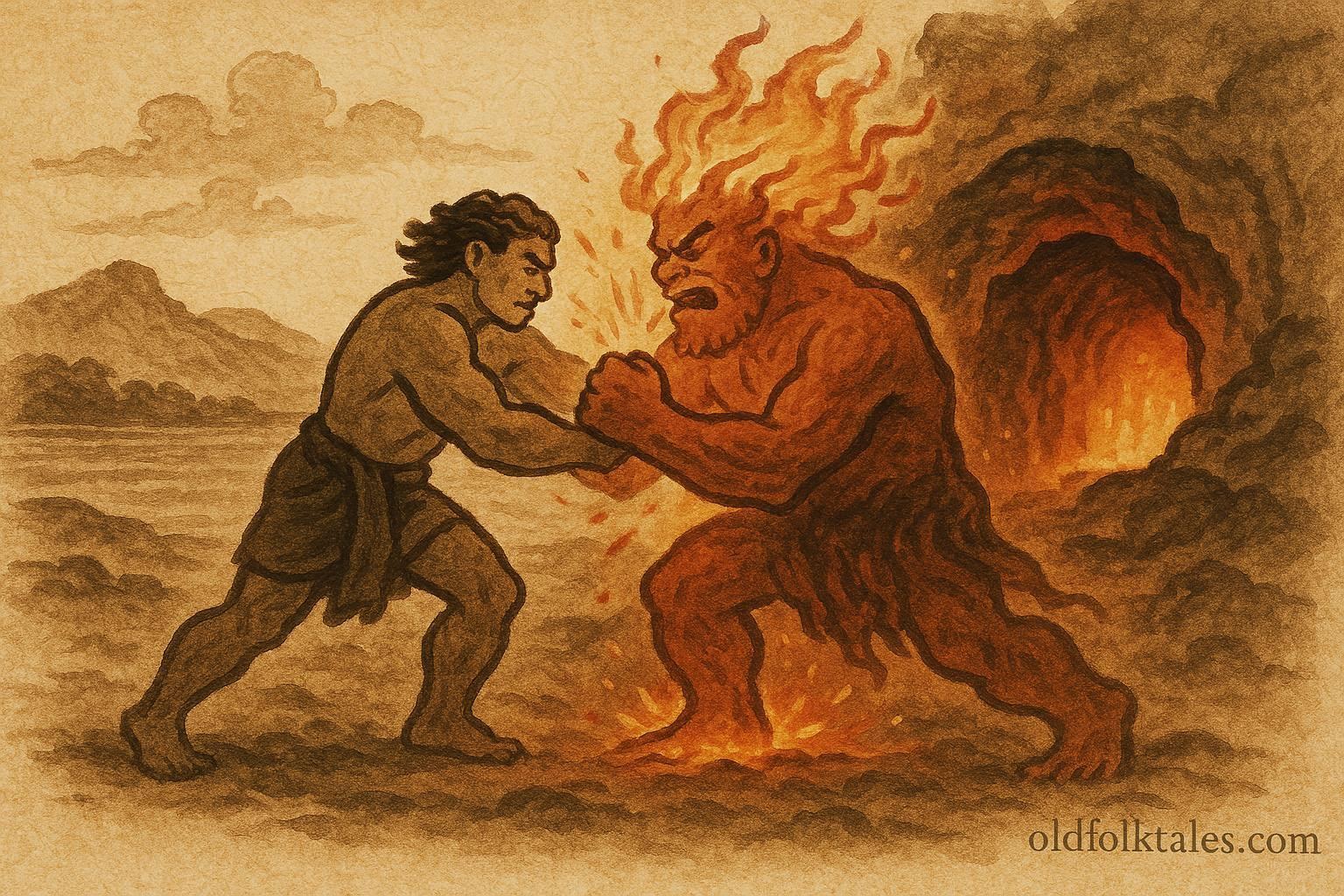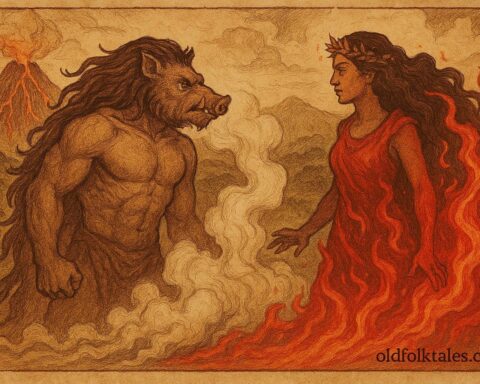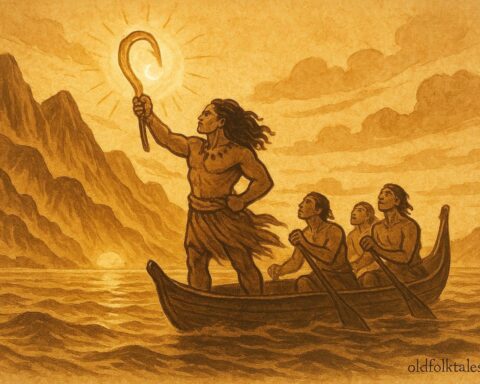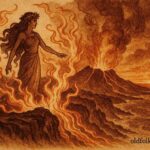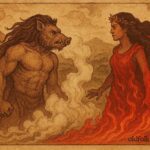In the ancient days of Samoa, when the gods still walked the earth and mortals lived close to the divine, there was no fire in the world. The people ate raw food, huddled in the dark when night fell, and shivered through the rains. The warmth of the sun blessed them by day, but when the sky turned black, cold shadows ruled the land.
Far beneath the earth lived Mafui‘e, the fearsome god of earthquakes and fire. His power was vast, when he stamped his foot, the mountains shook, and when he exhaled in anger, smoke and flame burst from the deep places of the world. The fire he guarded burned in secret caverns far below, and no mortal dared to approach him.
But among the people lived a young man of great courage and quick mind named Ti‘iti‘i. He was clever, strong, and bold enough to dream of what others feared. One evening, as he watched his people eat raw roots and cold fish, Ti‘iti‘i’s heart grew restless. He gazed at the stars and said to himself,
“Why should the gods alone have fire while humans live in darkness? If Mafui‘e will not share his flame, I will go and take it.”
The elders warned him that no one who entered Mafui‘e’s realm ever returned. But Ti‘iti‘i’s resolve was unshaken. At dawn, he took a sturdy staff of tamanu wood, tied a woven girdle around his waist, and set out toward the mountain where the earth trembled.
The path to the underworld was perilous. The ground cracked beneath his feet, and sulfurous fumes filled the air. Yet Ti‘iti‘i pressed on, calling out to the unseen depths,
“Mafui‘e! Lord of the fire! Come forth and face me!”
The mountain rumbled. Rocks split apart, and from the darkness emerged a towering figure with skin like molten stone and eyes blazing with flame. The god’s voice shook the earth:
“Who dares disturb Mafui‘e, the keeper of the fire and the maker of earthquakes?”
“I am Ti‘iti‘i of Samoa,” the young man declared, standing firm though the ground quaked beneath him. “I have come for the fire that you hide from humankind. It is unjust that we should live without its light.”
Mafui‘e’s laughter rolled like thunder. “Foolish mortal! Fire is not for men. It is the breath of the earth and the wrath of the gods. Go back, or I will crush you beneath the mountains you walk upon!”
But Ti‘iti‘i did not retreat. He lifted his staff and struck the ground. “Then let us test your strength against mine!”
With a roar, Mafui‘e lunged forward. The earth shook violently as god and mortal clashed. Ti‘iti‘i dodged and struck with speed and cunning. He could not match the god’s power, but he relied on his agility and wits. The two wrestled beside the mouth of the fiery cavern, sparks flying and stones shattering under their struggle.
In the heat of the fight, Ti‘iti‘i seized Mafui‘e’s arm and twisted it with all his strength. There was a thunderous crack, and the god’s arm snapped! Mafui‘e bellowed in pain, the mountains groaning in sympathy. Still, Ti‘iti‘i did not release his hold. “Yield!” he cried. “Swear to give fire to humankind, or your power will remain broken forever!”
Mafui‘e, weakened and furious, tried to summon his strength, but Ti‘iti‘i’s grip held firm. At last, realizing his defeat, the god growled,
“You have bested me, mortal. Take the secret of fire, and may it serve your kind well.”
He lifted his remaining hand and pointed toward the trees growing above the mountains. “In the heart of the ifilele and fafie woods burns the hidden flame. Strike them together, and fire will be born. Teach your people this secret, and they shall never live in darkness again.”
With that, Mafui‘e withdrew into the depths of the earth, his broken arm marking his eternal loss. The mountain fell silent once more, and the smell of smoke lingered in the air.
Ti‘iti‘i, weary but triumphant, climbed back to the surface. He gathered two dry sticks of the sacred wood and rubbed them together as the god had taught. Sparks leapt, a tiny flame flickered, and for the first time, fire came to the people.
The villagers gasped as the flames danced before them, warm, bright, and alive. They roasted breadfruit and taro, feeling the sweet aroma rise into the night air. For the first time, light filled their homes and laughter echoed through the darkness. Ti‘iti‘i had done what no man before him dared: he had challenged a god and brought a gift that would change the world forever.
From that day on, whenever the earth trembled, the people remembered Mafui‘e’s broken arm and said, “The Fire God stirs beneath us.” But they also remembered Ti‘iti‘i, the brave youth whose courage lit the first hearth. His name became a symbol of human ingenuity and the triumph of spirit over might.
In time, the art of making fire spread across the islands. The Samoans cooked their food, warmed their homes, and crafted torches to guide their way at night. And whenever flames flickered in the darkness, the people told the story of Ti‘iti‘i, the hero who defied a god so that humankind might live in light.
Discover the adventures of Māui, Pele, and Tangaloa in the timeless Polynesian oral tradition
Moral Lesson
The legend of Ti‘iti‘i teaches that progress is born from courage and persistence. Even in the face of divine power, human intelligence and bravery can overcome fear. The fire of knowledge and discovery must be used wisely, not for destruction, but to enlighten and sustain life.
Knowledge Check (Q&A)
- Who is Ti‘iti‘i in Samoan mythology?
Ti‘iti‘i is a mortal hero who defied the god Mafui‘e to bring fire to humankind. - What was Mafui‘e the god of?
Mafui‘e was the god of earthquakes and fire, dwelling beneath the earth. - How did Ti‘iti‘i win fire from Mafui‘e?
He wrestled with Mafui‘e, broke his arm, and forced him to reveal how to make fire from wood. - What did Mafui‘e teach Ti‘iti‘i about fire?
He told him that the secret flame lies in certain woods, which can be struck together to produce fire. - What lesson does the story convey?
That courage, intelligence, and perseverance can help humankind overcome even the mightiest obstacles. - Why do the Samoans associate earthquakes with Mafui‘e?
They believe the tremors are caused when Mafui‘e moves beneath the earth, still bearing the wound from his battle with Ti‘iti‘i.
Source: Adapted from Polynesian Mythology and Ancient Traditional History of the New Zealand Race by Sir George Grey (1855) – Samoan versions cited in later adaptations.
Cultural Origin: Samoa (Polynesia)
